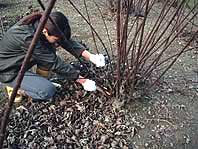 Branches from the shrubs used as raw materials are usually harvested from December
to January. The branches are cut off at an angle with a sickle.
Branches from the shrubs used as raw materials are usually harvested from December
to January. The branches are cut off at an angle with a sickle.
No.1 Harvesting raw materials
 Branches from the shrubs used as raw materials are usually harvested from December
to January. The branches are cut off at an angle with a sickle.
Branches from the shrubs used as raw materials are usually harvested from December
to January. The branches are cut off at an angle with a sickle.
No.2 Steaming branches
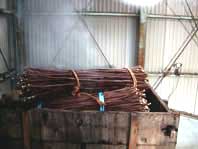 The
branches are steamed in a process called seiromushi, which can be easily done
by a few people. Seiromushi makes it easy to strip the branches of their bark.
The
branches are steamed in a process called seiromushi, which can be easily done
by a few people. Seiromushi makes it easy to strip the branches of their bark.
No.3 Stripping the bark
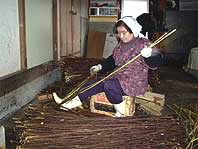 The branch is held in one hand and the bark in the other, and then both are
wedged between the feet so that the bark can be stripped from the branches in
such a way that the stripped bark makes a cylinder shape.
The branch is held in one hand and the bark in the other, and then both are
wedged between the feet so that the bark can be stripped from the branches in
such a way that the stripped bark makes a cylinder shape.
No.4 Drying black bark
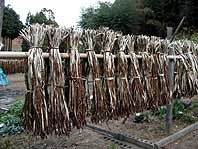 The
stripped black bark is tied up in bundles to be wind dried. After drying well,
the bark is stored.
The
stripped black bark is tied up in bundles to be wind dried. After drying well,
the bark is stored.
No.5 Scraping black bark
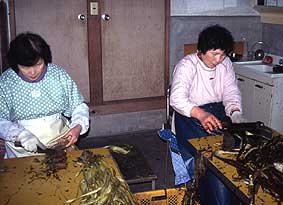 After the black bark is softened in water, each bark piece is put on a stand
and its outer layer is carefully scraped off with a knife.
After the black bark is softened in water, each bark piece is put on a stand
and its outer layer is carefully scraped off with a knife.
When using kozo, to heighten the quality, the epidermis is left between the
outer layer and the inner white layer.
No.6 Boiling
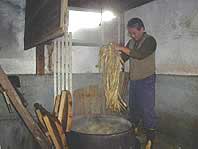 While cooking for 2 hours, the bark is turned every 30 minutes so that they
can be boiled evenly, and then steamed.
While cooking for 2 hours, the bark is turned every 30 minutes so that they
can be boiled evenly, and then steamed.
No.7 Removing impurities
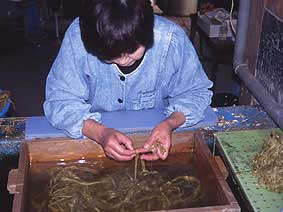 The boiled bark are individually inspected and placed in pure water where they
are all impurities are carefully picked out by hand.
The boiled bark are individually inspected and placed in pure water where they
are all impurities are carefully picked out by hand.
When using kozo, the harshness is first removed before doing the above procedure.
No.8 Beating
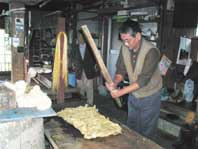 The bark is put on hard wooden boards and beaten with an oak stick to loosen
the individual fibers.
The bark is put on hard wooden boards and beaten with an oak stick to loosen
the individual fibers.
In Sekishu, the original method is used in which the bark is beaten 6 times
right and left and also 6 times up and down.。
No.9 Making the sheets
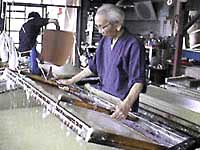 Water, a paper solution, and tororo-aoi are put into a vat, and evenly mixed
with a bamboo stick.
Water, a paper solution, and tororo-aoi are put into a vat, and evenly mixed
with a bamboo stick.
Three steps are then taken, called kazushi, choshi, and sutemizu, to make Sekishu
washi.
Kazushi
The paper solution is quickly scooped from the vat onto the mat to form the
paper sheet.
Choshi
The mat is shaken back and forth to spread the solution over the screen so that
the fibers intertwine and make layers.
The thickness varies according to the number of times the mat has been shook.
Sutemizu
Draining off the water.
When the layers have the desired thickness, the excess water and paper solution
on the su mat are drained off.。
No.10 Brushing
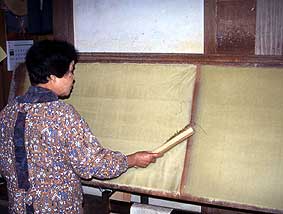 The
damp sheets are brushed onto wide boards to be dried.
The
damp sheets are brushed onto wide boards to be dried.
No.11 Drying
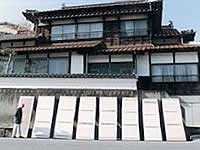 Drying
Drying
The sheets are dried outdoors on the boards.
While drying, washi is obtains its proper stiffness and beautiful appearance.